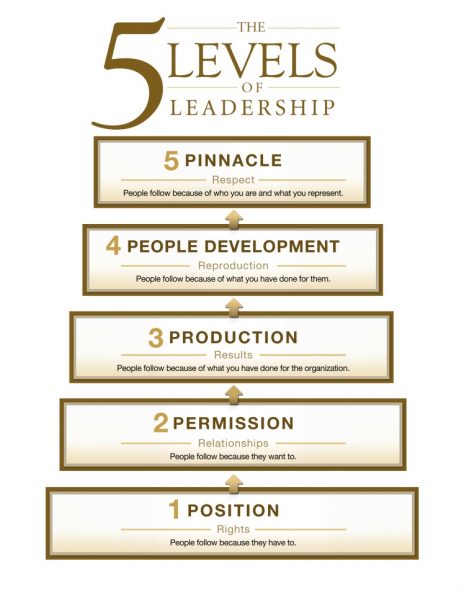As a kid, there will many notable leaders I admired and aspired to be like. I would often dress, speak, walk and act like them. While that helped motivate me, it did not in any way turn me into that particular leader. When I was given the opportunity for my first leadership position, I so made a mess of things and myself that I nearly gave up on wanting to become a leader.
Read more about Leadership
It will take me months of studies to come to understand that leadership does not just happen. It takes different processes. These processes are referred to as the levels of leadership development by the Leadership expert and author, John C. Maxwell. In his book of the same title, John Maxwell put forward the following as the 5 levels of leadership – Position, Permission, Production, People Development and Pinnacle.
Level One – Position
The position level of leadership is the foundational level and one at which everyone starts. This level of leadership is the layman’s understanding of leadership and is the most common there is. At this level, you are seen and regarded as a leader simply because you have a position that mandates people to follow or obey you. People follow you not because they choose to but because they have to.
Level Two – Permission
The second level of leadership is where it could be said that real leadership begins. This is because at this level people do not follow you because of the position you hold but because they choose to. This choice however is not automatic, it is earned through relationship and influence. This is why John Maxwell stated that ‘leadership is influence, nothing more, nothing less. As you intentionally begin to build a relationship with people, they will get the more to understand more about you – your character, values and convictions, that they willingly follow you.
Sign up for the Connect Nigeria daily newsletter
Level Three – Production
The third level of leadership which is the production level is the level where your leadership is judged by the results you have achieved. This is why I love to define leadership as the initiative to mobilize all resources toward achieving the desired result. Let’s face it, leaders are judged at the end of the day, basically, at the results they have been able to achieve. Promotions are not made based on how long you have stayed within an organization but on how much you have achieved for the organization, in terms of results.
John Maxwell summed up the demands of getting to this level when he pointed out that:
Leaders can get to Level 1 for an almost endless number of reasons: They show promise. They have connections. They play politics. They have seniority. The organization is desperate. You name it, and someone has probably received a leadership position because of it. Leaders who are naturally good with people or who take pains to learn people skills can move up to Level 2. But some people never move up from Level 2 Permission to Level 3 Production. Why? They can’t seem to produce results. When that is the case, it’s usually because they lack the self-discipline, work ethic, organization, or skills to be productive. However, if you desire to go to higher levels of leadership, you simply have to produce. There is no other way around it.
Register to attend the Connect Nigeria Business Mixer
Level Four – People Development
Every true leadership must be able to reproduce itself. And to do that it must be able to invest in the people being led. This is what this level of leadership entails. At this level, people will follow you because of what you have done for them.
Level Five – Pinnacle
This is the highest level of leadership and at this level, people follow a leader because of who you are and what you represent. Leaders who are at this level are those who have been able to help others rise to level four of their leadership. This is why level five leaders are rare in society and organizations.
Closing Thoughts
If you are or were like the ‘former me’, it is important that you understand and take note of these levels of leadership. Understand the level you are currently in your leadership and begin work on getting to the next levels.
Featured Image Source: Psychology For Marketers
Got a suggestion? Contact us: [email protected]


